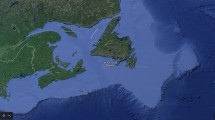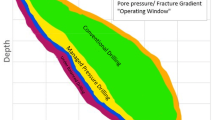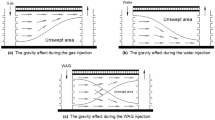Abstract
This study presents a workflow to optimize the location of CO2 injectors in order to maximize stored volume and prevent fault reactivation due to increases of pore pressure. We combine coupled reservoir flow and geomechanics simulations with neural network surrogate models and find the best injector location based on net present environmental value (NPEV). The surrogate models can complement the numerical reservoir simulations and efficiently optimize the well location and injection rate via the steepest ascent algorithm. We apply the workflow to the Brugge field, a closed synthetic reservoir that incorporates multiple faults, as an example. The surrogate model predicts a NPEV of approximately 0.19 billion carbon credits for the Brugge field, which is consistent with the corresponding reservoir simulation. NPEV will change under different safety factors that serve as an additional injection control to enhance the safety of injection. This proposed workflow could be readily applied to other similar reservoir models.
Similar content being viewed by others
References
Bachu, S.: CO2 storage in geological media: role, means, status and barriers to deployment. Prog. Energy Combust. Sci. 34, 254–273 (2008). https://doi.org/10.1016/j.pecs.2007.10.001
Benson, S.M., Cole, D.R.: CO2 sequestration in deep sedimentary formations. Elements. 4, 325–331 (2008). https://doi.org/10.2113/gselements.4.5.325
Lake, L.W., 1989. Enhanced Oil Recovery
Cappa, F., Rutqvist, J.: Modeling of coupled deformation and permeability evolution during fault reactivation induced by deep underground injection of CO2. Int. J. Greenh. Gas Control. 5, 336–346 (2011). https://doi.org/10.1016/j.ijggc.2010.08.005
Faulkner, D.R., Sanchez-Roa, C., Boulton, C., den Hartog, S.A.M.: Pore fluid pressure development in compacting fault gouge in theory, experiments, and nature. J. Geophys. Res. Solid Earth. 123, 226–241 (2018). https://doi.org/10.1002/2017JB015130
Ju, X., Fu, P., Settegast, R.R., Morris, J.P.: A coupled thermo-hydro-mechanical model for simulating leakoff-dominated hydraulic fracturing with application to geologic carbon storage. Int. J. Greenh. Gas Control. 109, 103379 (2021)
Rutqvist, J., Rinaldi, A.P., Cappa, F., Jeanne, P., Mazzoldi, A., Urpi, L., Guglielmi, Y., Vilarrasa, V.: Fault activation and induced seismicity in geological carbon storage – lessons learned from recent modeling studies. J. Rock Mech. Geotech. Eng. 8, 789–804 (2016). https://doi.org/10.1016/j.jrmge.2016.09.001
Stork, A.L., Verdon, J.P., Kendall, J.-M.: The microseismic response at the in Salah carbon capture and storage (CCS) site. Int. J. Greenh. Gas Control. 32, 159–171 (2015). https://doi.org/10.1016/j.ijggc.2014.11.014
Tang, H., Yan, B., Chai, Z., Zuo, L., Killough, J., Sun, Z.: Analyzing the well-interference phenomenon in the eagle ford shale/Austin chalk production system with a comprehensive compositional reservoir model. SPE Reserv. Eval. Eng. 22, 827–841 (2019b). https://doi.org/10.2118/191381-PA
White, J.A., Foxall, W.: Assessing induced seismicity risk at CO2 storage projects: recent progress and remaining challenges. Int. J. Greenh Gas Control. 49, 413–424 (2016). https://doi.org/10.1016/j.ijggc.2016.03.021
Zheng, X., Sun, Z., Espinoza, D.N., 2019. Uniaxial strain unloading compressibility of Frio sand: measurements and implications on reservoir pressure management for CO2 storage. 53rd U.S. rock Mech. Symp
Rinaldi, A.P., Vilarrasa, V., Rutqvist, J., Cappa, F.: Fault reactivation during CO2 sequestration: effects of well orientation on seismicity and leakage. Greenh. Gases Sci. Technol. 5, 645–656 (2015)
Zoback, M.D., Gorelick, S.M.: Earthquake triggering and large-scale geologic storage of carbon dioxide. Proc. Natl. Acad. Sci. 109, 10164–10168 (2012). https://doi.org/10.1073/pnas.1202473109
Jeanne, P., Guglielmi, Y., Cappa, F., Rinaldi, A.P., Rutqvist, J.: The effects of lateral property variations on fault-zone reactivation by fluid pressurization: application to CO2 pressurization effects within major and undetected fault zones. J. Struct. Geol. 62, 97–108 (2014). https://doi.org/10.1016/j.jsg.2014.01.017
Rutqvist, J., Birkholzer, J., Cappa, F., Tsang, C.-F.: Estimating maximum sustainable injection pressure during geological sequestration of CO2 using coupled fluid flow and geomechanical fault-slip analysis. Energy Convers. Manag. 48, 1798–1807 (2007). https://doi.org/10.1016/j.enconman.2007.01.021
Ryu, J., Espinoza, D.N., Balhoff, M.T., Tavassoli, S., 2019. Simulation of Fault Reactivation Using the HISS Model, in: SPE Annual Technical Conference and Exhibition. Society of Petroleum Engineers
Bruyelle, J., Guérillot, D., 2019. Well Placement Optimization with an Artificial Intelligence Method Applied to Brugge Field, in: SPE gas & oil Technology Showcase and Conference. OnePetro
Güyagüler, B., Horne, R.N., Rogers, L., Rosenzweig, J.J.: Optimization of well placement in a Gulf of Mexico waterflooding project. SPE Reserv. Eval. Eng. 5, 229–236 (2002)
Cardoso, M.A., Durlofsky, L.J.: Linearized reduced-order models for subsurface flow simulation. J. Comput. Phys. 229, 681–700 (2010)
Pan, I., Babaei, M., Korre, A., Durucan, S.: Artificial neural network based surrogate modelling for multi-objective optimisation of geological CO2 storage operations. Energy Procedia. 63, 3483–3491 (2014)
Queipo, N.V., Goicochea, J.V., Pintos, S.: Surrogate modeling-based optimization of SAGD processes. J. Pet. Sci. Eng. 35, 83–93 (2002a)
Tang, H., Bailey, W.J., Stone, T., Killough, J., 2019a. A Unified Gas/Liquid Drift-Flux Model for all Wellbore Inclinations. SPE J
Zerpa, L.E., Queipo, N.V., Pintos, S., Salager, J.-L.: An optimization methodology of alkaline–surfactant–polymer flooding processes using field scale numerical simulation and multiple surrogates. J. Pet. Sci. Eng. 47, 197–208 (2005)
Guo, Z., Reynolds, A.C., 2018. Robust Life-Cycle Production Optimization with a Support-Vector-Regression Proxy. SPE J
Jin, Y.: Surrogate-assisted evolutionary computation: recent advances and future challenges. Swarm Evol. Comput. 1, 61–70 (2011)
Mohaghegh, S.D., Modavi, C.A., Hafez, H.H., Haajizadeh, M., Kenawy, M.M., Guruswamy, S., 2006. Development of Surrogate Reservoir Models (SRM) for Fast Track Analysis of Complex Reservoirs, in: Intelligent Energy Conference and Exhibition. Society of Petroleum Engineers
Al-Bulushi, N.I., King, P.R., Blunt, M.J., Kraaijveld, M.: Artificial neural networks workflow and its application in the petroleum industry. Neural Comput. Appl. 21, 409–421 (2012)
Amiri, M., Ghiasi-Freez, J., Golkar, B., Hatampour, A.: Improving water saturation estimation in a tight shaly sandstone reservoir using artificial neural network optimized by imperialist competitive algorithm–a case study. J. Pet. Sci. Eng. 127, 347–358 (2015)
Anifowose, F.A., Labadin, J., Abdulraheem, A.: Non-linear feature selection-based hybrid computational intelligence models for improved natural gas reservoir characterization. J. Nat. Gas Sci. Eng. 21, 397–410 (2014)
Zhang, D., Chen, Y., Meng, J.: Synthetic well logs generation via recurrent neural networks. Pet. Explor. Dev. 45, 629–639 (2018)
Lippmann, R.: An introduction to computing with neural nets. IEEE ASSP Mag. 4, 4–22 (1987). https://doi.org/10.1109/MASSP.1987.1165576
Poulton, M.M.: Neural networks as an intelligence amplification tool: a review of applications. Geophysics. 67, 979–993 (2002)
White, A.C., Molnar, D., Aminian, K., Mohaghegh, S., Ameri, S., Esposito, P., 1995. The Application of ANN for Zone Identification in a Complex Reservoir, in: SPE Eastern Regional Meeting. Society of Petroleum Engineers
Yao, X., Liu, Y.: A new evolutionary system for evolving artificial neural networks. IEEE Trans. Neural Netw. 8, 694–713 (1997)
Aminian, K., Ameri, S.: Application of artificial neural networks for reservoir characterization with limited data. J. Pet. Sci. Eng. 49, 212–222 (2005)
Ghaffarian, N., Eslamloueyan, R., Vaferi, B.: Model identification for gas condensate reservoirs by using ANN method based on well test data. J. Pet. Sci. Eng. 123, 20–29 (2014)
Salehi, M.M., Rahmati, M., Karimnezhad, M., Omidvar, P.: Estimation of the non records logs from existing logs using artificial neural networks. Egypt. J. Pet. 26, 957–968 (2017)
Tariq, Z., Elkatatny, S., Mahmoud, M., Ali, A.Z., Abdulraheem, A., 2017. A New Approach to Predict Failure Parameters of Carbonate Rocks Using Artificial Intelligence Tools, in: SPE Kingdom of Saudi Arabia Annual Technical Symposium and Exhibition. Society of Petroleum Engineers
Ashrafi, S.B., Anemangely, M., Sabah, M., Ameri, M.J.: Application of hybrid artificial neural networks for predicting rate of penetration (ROP): a case study from Marun oil field. J. Pet. Sci. Eng. 175, 604–623 (2019)
Ahmadi, M.A., Soleimani, R., Lee, M., Kashiwao, T., Bahadori, A.: Determination of oil well production performance using artificial neural network (ANN) linked to the particle swarm optimization (PSO) tool. Petroleum. 1, 118–132 (2015)
Dahaghi, A.K., Mohaghegh, S.D., 2011. Numerical Simulation and Multiple Realizations for Sensitivity Study of Shale Gas Reservoirs, in: SPE Production and Operations Symposium. Society of Petroleum Engineers
Queipo, N.V., Pintos, S., Rincón, N., Contreras, N., Colmenares, J.: Surrogate modeling-based optimization for the integration of static and dynamic data into a reservoir description. J. Pet. Sci. Eng. 35, 167–181 (2002b)
Chen, Y., Oliver, D.S.: Ensemble-based closed-loop optimization applied to Brugge field. SPE Reserv. Eval. Eng. 13, 56–71 (2010)
Dehdari, V., Oliver, D.S.: Sequential quadratic programming for solving constrained production optimization--case study from Brugge field. SPE J. 17, 874–884 (2012)
Peters, L., Arts, R., Brouwer, G., Geel, C., Cullick, S., Lorentzen, R.J., Chen, Y., Dunlop, N., Vossepoel, F.C., Xu, R., Sarma, P., Alhuthali, A.H.H., Reynolds, A.: Results of the Brugge benchmark study for flooding optimization and history matching. SPE Reserv. Eval. Eng. 13, 391–405 (2010). https://doi.org/10.2118/119094-PA
Minkoff, S.E., Stone, C.M., Bryant, S., Peszynska, M., Wheeler, M.F.: Coupled fluid flow and geomechanical deformation modeling. J. Pet. Sci. Eng. 38, 37–56 (2003)
CMG: GEM user’s Guide. Comput. Model. Gr. Ltd., Calgary, Alberta (2018)
Kim, J., Tchelepi, H.A., Juanes, R., 2009. Stability, Accuracy and Efficiency of Sequential Methods for Coupled Flow and Geomechanics. SPE Reserv. Simul. Symp. https://doi.org/10.2118/119084-MS
Singh, G., Wheeler, M.F.: Compositional flow modeling using a multi-point flux mixed finite element method. Comput. Geosci. 20, 421–435 (2016). https://doi.org/10.1007/s10596-015-9535-2
Rachford, H.H., Rice, J.D.: Procedure for use of electronic digital computers in calculating flash vaporization hydrocarbon equilibrium. J. Pet. Technol. 4, 13–19 (1952). https://doi.org/10.2118/952327-G
Peng, D.-Y., Robinson, D.B.: A new two-constant equation of state. Ind. Eng. Chem. Fundam. 15, 59–64 (1976)
Delshad, M., Kong, X., Wheeler, M.F., 2011. On Interplay of Capillary, Gravity, and Viscous Forces on Brine/CO2 Relative Permeability in a Compositional and Parallel Simulation Framework, in: SPE Reservoir Simulation Symposium. OnePetro
Gupta, A.K., Bryant, S.L., 2010. Analytical Models to Select an Effective Saline Reservoir for CO2 Storage, in: SPE Annual Technical Conference and Exhibition. OnePetro
Jung, H., Singh, G., Espinoza, D.N., Wheeler, M.F.: Quantification of a maximum injection volume of CO2 to avert geomechanical perturbations using a compositional fluid flow reservoir simulator. Adv. Water Resour. 112, 160–169 (2018). https://doi.org/10.1016/j.advwatres.2017.12.003
Kumar, A., 2004. A Simulation Study of Carbon Sequestration in Deep Saline Aquifers
Li, B., Tchelepi, H.A., Benson, S.M.: Influence of capillary-pressure models on CO2 solubility trapping. Adv. Water Resour. 62, 488–498 (2013)
Garcıa, J.E., 2001. Density of Aqueous Solutions of CO2. Lawrence Berkeley Natl. Lab
Pedersen, K.S., Fredenslund, A., Christensen, P.L., Thomassen, P.: Viscosity of crude oils. Chem. Eng. Sci. 39, 1011–1016 (1984)
Scharlin, P., Cargill, R.W.: Carbon Dioxide in Water and Aqueous Electrolyte Solutions. Oxford University Press (1996)
Zaytsev, I.D., Aseyev, G.G.: Properties of Aqueous Solutions of Electrolytes. CRC press (1992)
Tran, D., Shrivastava, V.K., Nghiem, L.X., Kohse, B.F., 2009. Geomechanical risk mitigation for CO2 sequestration in saline aquifers. SPE Annu. Tech. Conf. Exhib. https://doi.org/10.2118/125167-MS
Bense, V.F., Person, M.A.: Faults as conduit-barrier systems to fluid flow in siliciclastic sedimentary aquifers. Water Resour. Res. 42, (2006)
Caine, J.S., Evans, J.P., Forster, C.B.: Fault zone architecture and permeability structure. Geology. 24, 1025–1028 (1996). https://doi.org/10.1130/0091-7613(1996)024<1025:FZAAPS>2.3.CO;2
Lee, S.-Y., Carle, S.F., Fogg, G.E.: Geologic heterogeneity and a comparison of two geostatistical models: sequential Gaussian and transition probability-based geostatistical simulation. Adv. Water Resour. 30, 1914–1932 (2007)
Horowitz, J., Cronin, J.-A., Hawkins, H., Konda, L., Yuskavage, A., 2017. Methodology for Analyzing a Carbon Tax. US Dep. Treasury, Washington, DC
Otake, M.: Evaluation of CO2 underground behavior from injector’s time-lapse pressure fall off analysis: a case study of CO2 aquifer storage project. Energy Procedia. 37, 3307–3318 (2013)
Liebscher, A., Möller, F., Bannach, A., Köhler, S., Wiebach, J., Schmidt-Hattenberger, C., Weiner, M., Pretschner, C., Ebert, K., Zemke, J.: Injection operation and operational pressure–temperature monitoring at the CO2 storage pilot site Ketzin, Germany—design, results, recommendations. Int. J. Greenh Gas Control. 15, 163–173 (2013)
Trupp, M., Frontczak, J., Torkington, J.: The gorgon CO2 injection project–2012 update. Energy Procedia. 37, 6237–6247 (2013)
White, J.A., Chiaramonte, L., Ezzedine, S., Foxall, W., Hao, Y., Ramirez, A., McNab, W.: Geomechanical behavior of the reservoir and caprock system at the in Salah CO2 storage project. Proc. Natl. Acad. Sci. 111, 8747–8752 (2014)
Hansen, O., Gilding, D., Nazarian, B., Osdal, B., Ringrose, P., Kristoffersen, J.-B., Eiken, O., Hansen, H.: Snøhvit: the history of injecting and storing 1 Mt CO2 in the fluvial Tubåen Fm. Energy Procedia. 37, 3565–3573 (2013)
Verdon, J.P., Kendall, J.-M., Stork, A.L., Chadwick, R.A., White, D.J., Bissell, R.C.: Comparison of geomechanical deformation induced by megatonne-scale CO2 storage at Sleipner, Weyburn, and in Salah. Proc. Natl. Acad. Sci. 110, E2762–E2771 (2013)
Tawiah, P., Duer, J., Bryant, S.L., Larter, S., O’Brien, S., Dong, M.: CO2 injectivity behaviour under non-isothermal conditions–field observations and assessments from the quest CCS operation. Int. J. Greenh. Gas Control. 92, 102843 (2020)
Finley, R.J., Frailey, S.M., Leetaru, H.E., Senel, O., Couëslan, M.L., Scott, M.: Early operational experience at a one-million tonne CCS demonstration project, Decatur, Illinois, USA. Energy Procedia. 37, 6149–6155 (2013)
Fausett, L., 1994. Fundamentals of Neural Networks: Architectures, Algorithms, and Applications. Prentice-Hall, Inc.
Rolon, L., Mohaghegh, S.D., Ameri, S., Gaskari, R., McDaniel, B.: Using artificial neural networks to generate synthetic well logs. J. Nat. Gas Sci. Eng. 1, 118–133 (2009)
Zendehboudi, S., Rezaei, N., Lohi, A.: Applications of hybrid models in chemical, petroleum, and energy systems: a systematic review. Appl. Energy. 228, 2539–2566 (2018)
Ceryan, N., Can, N.K., 2018. Prediction of The Uniaxial Compressive Strength of Rocks Materials, in: Handbook of Research on Trends and Digital Advances in Engineering Geology. IGI Global, pp. 31–96
Gardner, M.W., Dorling, S.R.: Artificial neural networks (the multilayer perceptron)—a review of applications in the atmospheric sciences. Atmos. Environ. 32, 2627–2636 (1998)
Adedigba, S.A., Khan, F., Yang, M.: Dynamic failure analysis of process systems using neural networks. Process. Saf. Environ. Prot. 111, 529–543 (2017)
Sapna, S., Tamilarasi, A., Kumar, M.P.: Backpropagation learning algorithm based on Levenberg Marquardt algorithm. Comp Sci Inf. Technol (CS IT). 2, 393–398 (2012)
Beale, M.H., Hagan, M.T., Demuth, H.B.: Neural network toolbox. User’s Guid. MathWorks. 2, 77–81 (2010)
Ding, S., Jiang, H., Li, J., Tang, G.: Optimization of well placement by combination of a modified particle swarm optimization algorithm and quality map method. Comput. Geosci. 18, 747–762 (2014)
Emerick, A.A., Silva, E., Messer, B., Almeida, L.F., Szwarcman, D., Pacheco, M.A.C., Vellasco, M.M.B.R., 2009. Well Placement Optimization Using a Genetic Algorithm with Nonlinear Constraints, in: SPE Reservoir Simulation Symposium. OnePetro
Montes, G., Bartolome, P., Udias, A.L., 2001. The Use of Genetic Algorithms in Well Placement Optimization, in: SPE Latin American and Caribbean Petroleum Engineering Conference. OnePetro
Acknowledgements
This work was supported by ExxonMobil through its membership in The University of Texas at Austin Energy Institute. The authors are thankful to the ExxonMobil team for providing meaningful comments and generating the discussions that helped guide this research.
Author information
Authors and Affiliations
Corresponding author
Additional information
Publisher’s note
Springer Nature remains neutral with regard to jurisdictional claims in published maps and institutional affiliations.
Rights and permissions
About this article
Cite this article
Sun, Z., Xu, J., Espinoza, D.N. et al. Optimization of subsurface CO2 injection based on neural network surrogate modeling. Comput Geosci 25, 1887–1898 (2021). https://doi.org/10.1007/s10596-021-10092-9
Received:
Accepted:
Published:
Issue Date:
DOI: https://doi.org/10.1007/s10596-021-10092-9




